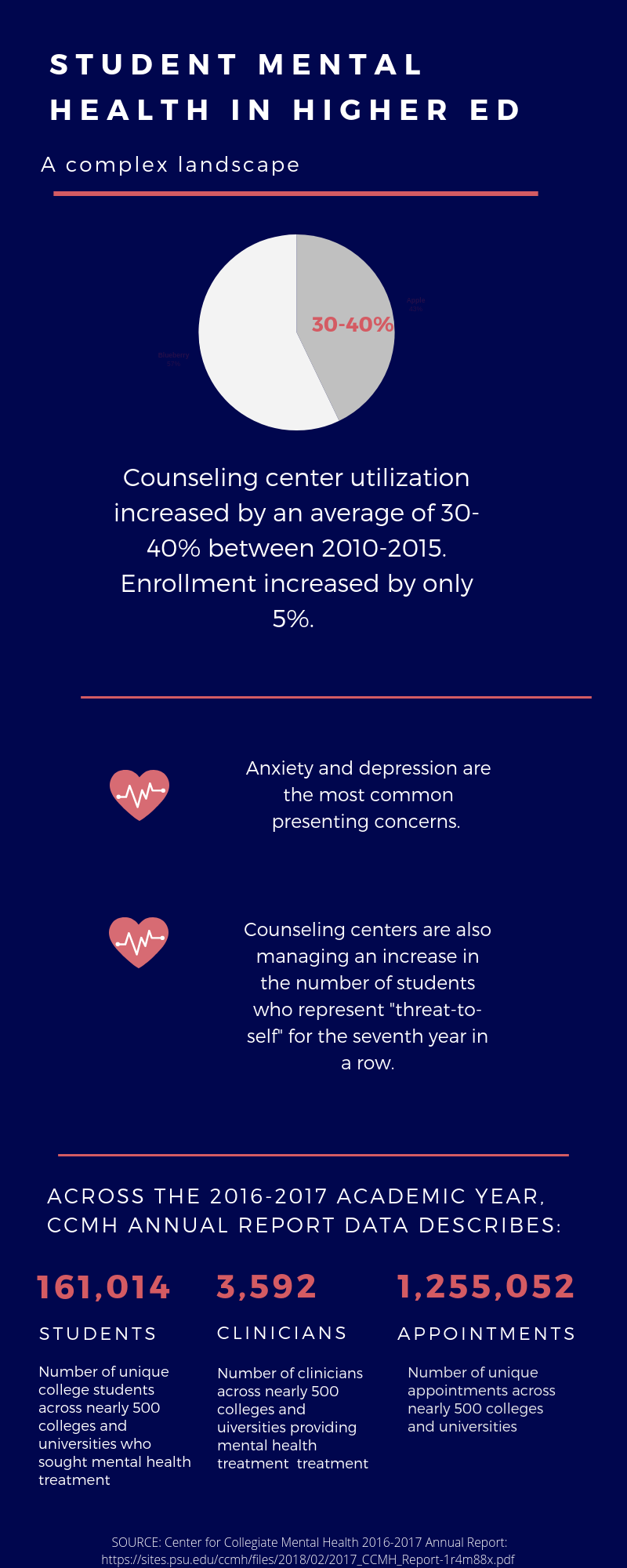
There has been a lot of media attention to college student mental health statistics and to the upsurge in demand for mental health services. But does the data really suggest a mental health “crisis”? What does the upsurge actually mean for postsecondary institutions? Where do we need to shift the conversation, and what do we need to do next? Learn more in the infographic and article below.
What the Upsurge in Demand for Mental Health Services Means (and Doesn’t Mean)
The first thing I want to underscore is that institutions are facing an unprecedented level of demand from students seeking help and support for mental health issues. Counseling centers are not new on campus–and mental health services are certainly not new–but the upsurge in volume from students accessing these services is. The two main presenting issues we’re seeing in students are anxiety and depression.
The other issue institutions are concerned about but that is statistically much less frequent is suicidality. If you read the press on this topic, there are a lot of articles that emphasize the number of college students committing suicide. That’s obviously a horrible mental health outcome and something institutions are investing prevention and education efforts around, but many of the mental health and counseling practitioners I’ve spoken with at colleges and universities emphasize that suicide rates among college students are in fact comparable to or lower than the national averages. There is a grain of truth in the feeling among practitioners that when the press addresses student suicide or labels it a “crisis,” the issue is a little overhyped.
The other side of it that we can’t forget is that for decades, both in higher ed and in the mental health space in general, physicians and health promotions professionals have been working to normalize mental health, destigmatize it, make it safer for people to come forward and seek help for mental health issues they’re struggling with.
In reality, it is a good problem to have that students are coming forward in such large numbers to access counseling services. It is evidence that higher education and the mental health community have moved the needle on this work. That is the piece of the narrative that gets left out of a lot of the press around this issue.
Let’s look at the data:

Pressure on the Dean of Students
We all know about the strain that the upsurge of demand places on counseling centers and mental health services; what we don’t see talked about as much is the pressures deans of students are facing. The dean of students has a unique role in the mental health landscape.
Addressing mental health in higher education is complex, involving many stakeholders, including deans of students, directors of counseling centers, health promotion and prevention professionals (who may work in a counseling center or in a more holistic health and wellness center), and case managers. Institutions also have behavioral intervention teams and threat assessment teams comprised of others from different functions around the university. Depending on your role, your challenges and involvement in this work may look very different.
Deans of students frequently serve as “hubs” for the various “spokes” of professionals who are dealing with cases of mental health. They are often the arbiters between students with mental health concerns and faculty members who may have had interactions with these students in the classroom. I’ll give you an example. Maybe the faculty member and the student have had a conflict that was visible and in front of the class. The faculty member is angry and files a report with the dean of students recommending that the student be disciplined. The dean of students then meets with the student one-on-one to get their side of the story and learns, in the course of that conversation, that the student has a mental health concern. And what might be a 10 on the unacceptable scale for student behavior from the faculty member’s perspective might be a 3 for the dean of students who understands the student’s mental health context.
The questions the dean of students has to weigh are: Is it in the best interest of the student to move forward with the disciplinary action? Should we view this as a conduct issue or as symptomatic of their mental health issue? They have to make a judgment call: What is in the student’s best interest? How do I also protect the faculty member? What do I do?
And that judgment call has to weigh not only the ethical issues involved, but also significant legal and regulatory issues. Using that same example, if the dean of students finds out in their conversation with the student that the student is expressing suicidal thoughts, or if the dean of students determines the student is at risk for suicide, the question becomes: At what point do I notify the parents? On the face of it, that seems like a simple question. But in higher education, we’re bound by FERPA, which prohibits the sharing of student information with the parents unless the student has given permission. There are certain stipulations in FERPA that permit reaching out to parents in certain instances, but that is something the dean of students has to weigh.
What institutions are having to do now is refine their policies on parent notification: When do they notify? When do they not notify? Institutions are striving to define these protocols so that when it’s time to make that judgment call, the dean of students (or others) can make the decision deftly and swiftly. (There are other compliance issues that we need to define protocols for, as well.)
There have been several high-profile instances recently (MIT, in particular) in which the responsibility of the university to protect students from suicide has been called into question. These cases have led deans of students to focus more effort on defining protocols around things like parent notification. Deans of students are hungrier for information on what recent cases have been and what legal exceptions there are. But every case is different, every case is unique. At the end of the day, deans of students need to seek training where they walk through scenarios and practice making these judgment calls.
Shifting the Conversation: From Reactive to Proactive
There is growing demand for mental health services, but institutions have limited staff to address that demand. It’s increasingly apparent that this is not a challenge institutions can hire their way out of. Certainly, hiring more counseling center staff will help, but it is not in of itself a sustainable solution to reduce the prevalence of student mental health issues on campus. Now the conversation is shifting more than ever toward prevention and health promotion work. Institutions are investing–and need to invest more–in proactive approaches: education and training, building student resilience, and dealing with root causes of student anxiety. More institutions are developing campaigns around mental health awareness and resilience.
This shift from a reactive to a proactive stance has two ramifications:
First, we have to integrate what have often been disparate efforts on campus. There are two conversations about student resilience happening on many campuses, often separately. One conversation, conducted through an academic lens and drawing on the research of Angela Duckworth and others, is focused on how students can develop academic grit and persist. The other conversation is focused on emotional fortitude and overcoming adversity–not just specific to situations in the academic classroom but more holistically: How do you become more resilient in your life?
In reality, you can’t separate mental health from academics. The old argument that institutions can just focus on education and not address student mental health doesn’t hold water, because mental health issues fundamentally impact student learning and student success. So the challenge now is that we have to get these two conversations–about academic grit and emotional fortitude–intertwined.
Second, the work is too large to be borne by the counseling center alone. The scope of the issue is too large. Some of the promotion and prevention work that is happening right now is to train as many people as possible to understand:
- How do they recognize when a student is experiencing a mental health crisis?
- Once they have identified this, what do they then do?
For efforts to address mental health on campus to be successful, we need as many eyes and ears attuned to these issues as possible. The task now is to train more of the institution’s staff. Faculty, not counseling center staff, are on the front lines with students every day and are among those likely to be the first to see an issue. The same is true of academic advisors, career services professionals, and residence life staff. So we are beginning to see more directed, intentional training for staff in those functional areas, to help them recognize what a mental health crisis looks like.
Photo above by Kevin Grieve on Unsplash.
Infographic by Academic Impressions.


